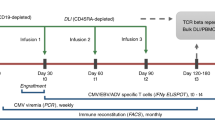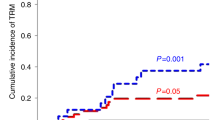Abstract
Recipients of marrow from alternative donors (unrelated or HLA-mismatched related donors) have a higher incidence of post-transplant complications compared to recipients of marrow from HLA-identical siblings. HLA disparity undetected by routine typing techniques has been suggested as one cause for the increased complications observed. Limiting dilution analysis (LDA) of donor-derived, host-reactive T cell precursor frequency prior to transplant has been proposed as a surrogate indicator of underlying HLA disparity which might be used to predict transplant outcome and aid in donor selection. We compared results of LDA of host-reactive IL-2 producing helper T lymphocytes (HTLp) and/or cytolytic T lymphocytes (CTLp) in 77 alternative marrow donor/recipient pairs with transplant outcome using univariate and multivariate analysis. All donor grafts were depleted ex vivo of mature T cells. Median patient age was 15 years (1–53). Donor selection was based on serologic typing for HLA class I and high resolution oligotyping for HLA-DRB1-DRB5, and HLA-DQB1. HLA-A and HLA-B locus antigens were retrospectively defined by one dimensional isoelectric focusing (IEF). Cox proportional hazards regression models were used to assess the impact of frequency and estimated cell dose of CTLp and HTLp on outcome. The CTLp assay was most sensitive to HLA-A and HLA-B locus disparity detected by serology or IEF. The HTLp assay detected class I disparity but was most strongly reactive in the presence of HLA-DRB1 disparity. Univariate analysis indicated a significant association of CTLp frequency and dose with severe (grades 3–4) acute graft-versus-host disease (GVHD), and of CTLp dose with chronic GVHD. Both assays were associated with survival and neither assay was associated with relapse. After adjustment for other significant covariables including known HLA disparity, the association of CTLp with acute GVHD was lost, however, CTLp frequency and CTLp dose remained associated with survival and HTLp frequency was associated with chronic GVHD. These data support the hypothesis that post-BMT complications may be influenced not only by T cell dose but by the alloreactive potential of the cells infused. LDA of alloreactive potential was useful in detecting disparity and in predicting survival or chronic GVHD in recipients of alternative donor TCD marrow grafts.
This is a preview of subscription content, access via your institution
Access options
Subscribe to this journal
Receive 12 print issues and online access
$259.00 per year
only $21.58 per issue
Buy this article
- Purchase on Springer Link
- Instant access to full article PDF
Prices may be subject to local taxes which are calculated during checkout
Similar content being viewed by others
Author information
Authors and Affiliations
Rights and permissions
About this article
Cite this article
Keever-Taylor, C., Passweg, J., Kawanishi, Y. et al. Association of donor-derived host-reactive cytolytic and helper T cells with outcome following alternative donor T cell-depleted bone marrow transplantation. Bone Marrow Transplant 19, 1001–1009 (1997). https://doi.org/10.1038/sj.bmt.1700779
Received:
Accepted:
Issue Date:
DOI: https://doi.org/10.1038/sj.bmt.1700779
Keywords
This article is cited by
-
Prevention of relapse after allogeneic hematopoietic cell transplantation by donor and cell source selection
Bone Marrow Transplantation (2018)
-
Highly diverged MHC class I mismatches are acceptable for haematopoietic stem cell transplantation
Bone Marrow Transplantation (2007)
-
The HistoCheck algorithm does not predict T-cell alloreactivity in vitro
Bone Marrow Transplantation (2005)
-
Improved detection of clinically significant host-reactive antigens prior to HLA-identical sibling peripheral blood stem cell transplantation using a dendritic cell-based helper T-lymphocyte precursor assay
Bone Marrow Transplantation (2004)
-
Donor T-lymphocyte infusion for unrelated allogeneic bone marrow transplantation with CD3+ T-cell-depleted graft
Bone Marrow Transplantation (2003)



